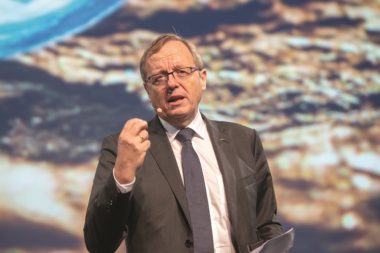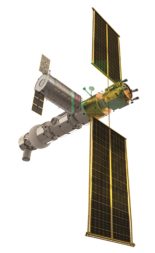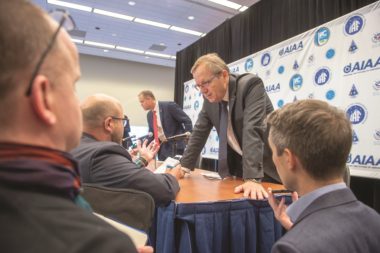With ESA set to convene its triennial ministerial later this month, SpaceNews spoke with ESA Director General Jan Woerner about his hopes for Space19+
In a conference room at the Washington Convention Center, site of the 70th International Astronautical Congress, Jan Woerner slouches a bit in his chair. As director general of the European Space Agency, IAC is one of the busiest weeks of the year, his schedule filled with appearances in conference sessions and meetings with other space agencies. The interview he’s sitting down for, at least, is in the home stretch of the conference, with the end of the week in sight.
It’s also the home stretch for something far bigger than a conference. On Nov. 27, ministers from ESA’s 22 member states will gather in Seville, Spain, for a meeting dubbed “Space19+” by the agency. At that two-day meeting, those ministers will make funding decisions for ESA programs for the next three years, spanning from participation in NASA’s Artemis lunar exploration program to projects addressing orbital debris and near Earth asteroids.
Woerner and his team have been preparing for Space19+ for a long time. “We started the preparation something like two years ago, which sounds long,” or shortly after the previous ministerial meeting in late 2016, he said. “But it was important to me because, after that ministerial, you know what is going on and it’s the best place to think about what is missing for the future.”
FOUR PILLARS
Those preparations, Woerner said, didn’t begin with specific programs or missions. “We started with a narrative, to have a clear picture of what ESA is doing,” he said. “That was very important from my point of view.”
That led to the development of what ESA calls its “four pillars” of programs. One, science and exploration, includes its science missions as well as human spaceflight. The second, applications, covers Earth science, navigation and telecommunications. Launch vehicles, ground stations and related infrastructure falls in a third category, called enabling and support. The last pillar, space safety, includes a variety of topics like space weather, planetary defense, orbital debris and even cybersecurity.

ESA has gone all-in on that model. The agency recently revamped its website to emphasize those four pillars, and now categorizes every press release and article it publishes in one of those four color-coded categories: red for science and exploration, green for applications, orange for enabling and support and blue for space safety. ESA even sells a Space19+ t-shirt with those four pillars represented by colored lines running across the front and back of the shirt.
ESA’s budget proposal for Space19+ is structured around those four pillars. The agency is seeking 12.5 billion euros ($13.8 billion) over three years in funding from its member states. The first three pillars — science and exploration, applications and enabling and support — would each get about 30% of the budget. Space safety accounts for most of the rest, or about 7%.
That simple budget, though, belies the complexity of getting that funding. Some programs are mandatory, in that all ESA members have to contribute, while others are funded on a country-by-country basis. While most of the programs will be funded over three years, others will be funded for five, and some funding is already earmarked for programs approved at the prior ministerial meeting in 2016.
At a press conference during the IAC, someone asked Woerner how much of a budget increase ESA was seeking. “The question seems to be very simple, but the answer is complicated,” he said, and what followed was a long discussion of funding profiles and “budget corridors” for various programs. “The effect is that we have a 10% increase per year,” he finally said. “It is financial engineering.”
The financial engineering will come to a head in Seville when the ministers meet. Each nation will review what’s known as “Document 100,” a menu of sorts that lists all the proposed programs and estimated costs, and then offer their contributions. “We will add those up and see whether we get the program or are under a certain threshold, or get an oversubscription,” Woerner said. “After one and a half days, this discussion should finally come to a conclusion with some final numbers.”
EXPLORATION PROGRAMS
One major area of Space19+ will be ESA’s contributions to human exploration programs. Ministers are expected to continue funding ESA’s share of International Space Station operations and assembly of additional Orion service modules, and approve plans to cooperate with NASA on a robotic Mars sample return effort.
ESA will also seek backing for a role in NASA’s Artemis program beyond the Orion service modules. “It’s a big ministerial for us for the future,” said David Parker, director of human and robotic exploration at ESA.
ESA is proposing to develop two modules for the Gateway. One, called European System Providing Refueling, Infrastructure and Telecommunications, or ESPRIT, would allow for refueling of NASA’s Power and Propulsion Element and provide high-bandwidth communications with spacecraft on the lunar surface. That would, Parker said, allow for sustained operations of the Gateway beyond the 2020s.
The second module would be a habitat. “We are waiting for definitive proposals from industry,” he said of the hab module, with Airbus and Thales Alenia Space expected to compete. “We should have the way forward for that by the end of the year or early next year.”
ESA is also seeking funding to start work on a lunar lander called the European Large Logistics Lander. That lander, Parker said, could carry one and a half tons of payload to the lunar surface, either to support human missions there or for large science payloads. “Another mission you could undertake is to return samples and material from the surface of the moon with an ascent vehicle,” he said, “and we’ve already studied that in the past few years with our Japanese and Canadian friends.”
NASA’s plans to move up the first human landing from 2028 to 2024 won’t affect ESA’s contributions to the Gateway or participation in the overall Artemis program. Parker said that the hab module was targeted for 2025 and ESPRIT for 2027. “It’s second order refinements” to those plans, he said. “Nothing’s fundamentally changed.”
If ESA does commit to broader participation in Artemis, one question that will likely arise among European governments is when an ESA astronaut will fly to the moon. “I think it is obvious that, by contributing to the Gateway, we are also looking forward to having astronaut seats available,” Woerner said. “We would be happy to send a European to the surface of the moon.”
The problem, he said, is that any talks about sending a European to the moon inevitably lead to debates about who that first European will be. “The Europeans are asking me this question each and every day,” he said. “They are not asking whether it’s a European, but whether it’s this or that nationality.”
“For me, nationality is not that important,” he continued, describing Luca Parmitano, an ESA astronaut currently on the ISS, as “a European astronaut with an Italian passport” rather than an Italian astronaut.
Woerner hopes Europeans will take the same approach as Americans, who don’t lobby for astronauts based on their home states. “I’ve never heard from [Vice President] Mike Pence or the president that the astronaut should be from Alabama or wherever,” he said. “That should be the same in Europe. I’m looking for European astronauts, as you’re looking for American astronauts.”
OTHER ISSUES
Exploration programs will get a lot of attention at Space19+, but other issues will come up during the meetings as well. At the previous ministerial, member states affirmed plans to develop the Ariane 6 and Vega C rockets, which are now scheduled to enter service in 2020.
With those vehicles about to enter the market, the question is how competitive they will be given on the global market. “The competition is fierce, that’s clear,” Woerner said.

The Ariane 6, he reiterated, should offer launches for satellites at half the cost of the Ariane 5. “But the global competition is not sleeping, and therefore we are looking into the future with new technologies.”
Those new technologies include reusability, a topic that Woerner has treated with some skepticism in the past but now appears more willing to support. ESA, he said, will fund research in a variety of approaches to reusability, such as powered vertical landings like SpaceX does with its Falcon 9 rockets as well as parachutes and winged bodies. “We’re looking at all of this and have some development programs to see what is the best opportunity for Europe,” he said.
ESA will also seek funding to support development of “microlaunchers,” or small launch vehicles, at the ministerial. “We think that with all of our activities — development of future launch systems and microlaunchers, development of Ariane 6 and Vega C — we can, and want to, play an important role in the launcher sector.”
Another issue, one unlikely to be resolved any time soon, is ESA’s role with the European Union and its growing space ambitions. Earlier this year, the EU unveiled a space budget that proposes to spend 16 billion euros from 2021 through 2027, primarily on the Copernicus program of Earth observation satellites and the Galileo satellite navigation system.
The EU, though, is now branching out into space situational awareness with the new budget, and some speculate the EU is angling to take on a larger role in overall European space efforts. Earlier this year, the EU proposed renaming the agency that oversees the Galileo program from the European Global Navigation Satellite Systems Agency to the European Union Agency for the Space Programme, prompting criticism from ESA, which is independent from the EU.
Woerner, though, downplayed any conflict between ESA and the EU. He noted that 80% of the EU space budget will go to ESA, which manages Copernicus and Galileo. That effectively increases ESA’s average annual budget over the next three years from about 4.2 billion euros to six billion euros.
“It’s a fruitful cooperation,” he said, likening the relationship with the EU to those ESA has with national space agencies that pursue their own programs in addition to working with ESA. “The situation is different from the U.S., but it’s fine.”
CAUTIOUS OPTIMISM
Member states are already familiar with what ESA is proposing for Space19+. The agency briefed ministers on its overall proposal earlier this year, and Woerner said they raised no red flags about any specific parts of the proposal.

“We’ve had already several discussions with the member states about all of these programs, and there is not a single program where the member states said, ‘Oh, this is a bad proposal,’” he said. “I asked them directly that question — they could send it to me confidentially to say to abandon this or that proposal — but there was not a single one.”
But there’s still uncertainty, he admitted, until the member states sit down in Seville and start filling out Document 100. Besides the division of ESA programs into four pillars, he said programs could be categorized in one of three ways: competition, inspiration and responsibility.
“It’s clear to get money for inspiration, because the reasoning is positive,” he said. “Competitiveness of industry? Of course you get money for that. I might even get an oversubscription in programs which are specifically looking to competitiveness.”
Responsibility, though, is a tougher sell. “To get money for responsibility is very difficult,” he said. “When we talk about things that do not have a direct return on investment, like debris removal or a solar flare early warning system, then it’s a little bit more difficult.”
That issue, he said, would particularly affect programs in the space safety pillar, like orbital debris and space weather as well as planetary defense. There is reason to be concerned: at the 2016 ministerial meeting, member states failed to fund the Asteroid Intercept Mission, which would have been part of a joint mission with NASA to test the ability of an impacting spacecraft to deflect the orbit of the asteroid.
NASA is going ahead with its part of the mission, called the Double Asteroid Redirection Test (DART). ESA will request money at Space19+ for a smaller mission called Hera that would visit the asteroid DART collided with a few years later.
Those concerns aside, Woerner said he felt upbeat going into Space19+. “I don’t know if we really will get the full amount we’re asking for, but I must say I’m really optimistic,” he said.
For the previous ministerial, he said he gave himself an incentive: if he secured a certain amount of funding, he would buy himself a new car. The meeting was a success and, sure enough, he bought a new car. “I haven’t decided what my personal incentive is this time,” he said. “I don’t need a new car.”
“You could get a Tesla,” another ESA official, sitting in on the interview, suggested. Woerner shook his head at the prospect of driving a car from a company whose chief executive also runs a company that’s a major competitor to Europe in launch. “I need to drive European as director general.”
This article originally appeared in the Nov. 11, 2019 issue of SpaceNews magazine.
"space" - Google News
November 23, 2019 at 02:55AM
https://ift.tt/2XNPlw5
ESA ministerial preview: Building the pillars for Europe's future in space - SpaceNews
"space" - Google News
https://ift.tt/2Q8TIzF
Shoes Man Tutorial
Pos News Update
Meme Update
Korean Entertainment News
Japan News Update
Bagikan Berita Ini














0 Response to "ESA ministerial preview: Building the pillars for Europe's future in space - SpaceNews"
Post a Comment